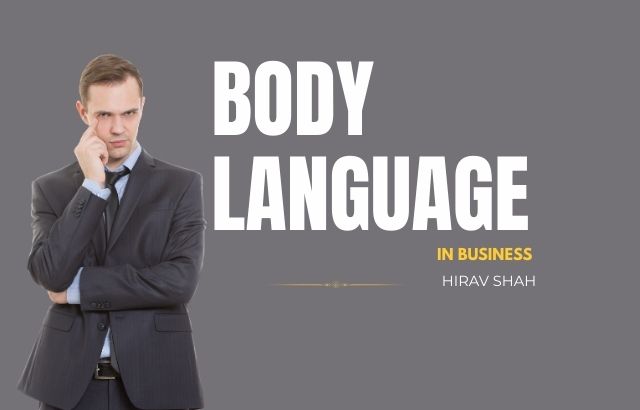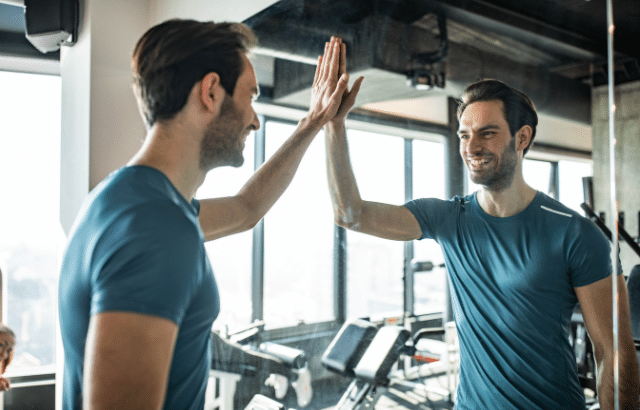Business Strategist Hirav Shah always says that authenticity speaks louder than anything else. And in this article, we explore one of the most authentic forms of communication—body language.
You’ll discover what body language really means, how it works in business communication, why it plays a bigger role than words, and how it can silently build or break your deals. From handshakes to posture, from eye contact to expressions, this article will decode the silent signals that decide your success in business meetings, negotiations, and leadership.
Table of Contents
What is Body Language and Why Does it Matter?
Body language is the unspoken expression of who you are. It’s the way you sit, stand, shake hands, make eye contact, and gesture while you speak. Psychologists suggest that more than half of human communication is non-verbal.
In business, this means that while you’re busy choosing the right words, others are already reading your confidence, sincerity, and intention through your body.
Think of it like cinema: before the hero speaks, his presence, walk, and expression already set the mood of the scene. In the same way, your body language creates the first impression in every business interaction.
Quote:
“Your body talks before your words do—make sure it says the right thing.” – Business Strategist Hirav Shah
How Does Body Language Work in Business Communication?
When you walk into a meeting room, people notice more than your clothes or your presentation file. They notice how you enter, how you sit, and how you look at them. Without realizing it, they begin forming opinions about you. This is how body language works—it communicates silently, shaping the way people perceive your personality, credibility, and confidence.
Think about this: if a leader walks into a boardroom with drooping shoulders, restless hands, and no eye contact, what impression does it create? Most likely, the team assumes that he is nervous or underprepared, even if his words later sound convincing. On the other hand, someone who walks in with a firm stride, maintains steady eye contact, and sits upright automatically commands attention. Before saying a word, one projects authority and readiness.
Business strategist Hirav Shah often explains that body language is like the “subtitles” of your words. Even if someone doesn’t fully understand what you are saying, they understand the emotion behind it through your gestures, expressions, and tone. A nod signals agreement, a smile builds rapport, and leaning slightly forward shows genuine interest. These small signals influence decisions more than we imagine.
There is also a psychological side to it. Humans are wired to observe non-verbal cues because, for centuries, survival depended on reading other people’s intentions quickly. That instinct is still alive in boardrooms today. Investors decide whether they trust you, clients decide whether they like you, and employees decide whether they respect you—largely based on how your body communicates.
Just like in cinema, where the background music sets the mood of a scene, body language works in the background of every business interaction. The words may be the dialogue, but gestures, expressions, and posture provide the emotional soundtrack. Together, they determine whether your message is taken seriously—or ignored.
Quote:
“The mind may hide, but the body always reveals the truth.” – Business Strategist Hirav Shah
What Are the Benefits of Positive Body Language in Business?
In business, numbers and presentations matter, but people often forget that deals are made between humans, not just spreadsheets. And humans connect more with what they see than what they hear. That’s why positive body language becomes your hidden advantage—it adds weight to your words and makes people believe in you.
Think about a simple scenario: Two entrepreneurs pitch the same idea to an investor. One speaks with slouched shoulders, avoids eye contact, and shuffles papers nervously. The other speaks with calm posture, steady gestures, and a confident smile. Who will the investor trust? The second one—because confidence is not only heard, it is seen.
Positive body language is not about acting—it’s about aligning your presence with your purpose. When your body supports your words, it builds instant credibility.
Key Benefits of Positive Body Language in Business:
- Builds Instant Trust:
People trust those whose body language reflects confidence and openness. A steady gaze and firm handshake communicate reliability better than long speeches. - Creates Powerful First Impressions:
Just like a movie trailer decides if the audience will watch the film, your first gestures decide if people will listen to you. - Improves Negotiations:
Calm, steady posture reduces tension in tough discussions and helps you project authority without aggression. - Strengthens Leadership Presence:
Teams follow leaders who not only speak with clarity but also look composed and focused. - Multiplies Communication Impact:
Research shows that when body language matches words, the message becomes more memorable and persuasive.
Business strategist Hirav Shah often says that good body language is like adding background music to your dialogue—it makes the scene more impactful, emotional, and believable. Without it, even the strongest lines lose power.
Quote:
“Good body language doesn’t just support your words—it multiplies their impact.” – Business Strategist Hirav Shah
How Important Is the First Impression—Handshake, Posture, and Entry?
In films, the hero’s first entry on screen creates magic. Even before he speaks a word, the audience knows whether to cheer for him or not. Business is no different. The way you walk into a room, shake hands, and take your seat can make or break the first impression.
Why is this so important? Because people form opinions within the first 7 seconds of meeting you. By the time you start talking about your product or strategy, your body language has already spoken volumes about your confidence, energy, and trustworthiness.
Imagine a meeting where one person walks in with a hesitant smile, a weak handshake, and hunched shoulders. Contrast that with another who enters with a steady step, firm handshake, upright posture, and calm eye contact. Who wins the room? The second one—every time.
Checklist for First Impressions in Business:
- Handshake: Firm but not crushing, steady eye contact while shaking.
- Entry: Walk tall, shoulders open, calm pace—don’t rush or hesitate.
- Posture: Sit upright, avoid slouching, lean slightly forward to show interest.
- Smile: A natural, warm smile shows confidence and openness.
- Eye Contact: Balanced—not staring, not avoiding.
Business strategist Hirav Shah explains that your first impression is like a film trailer—if it’s strong, people stay to see the whole story. If it’s weak, they mentally switch off before you even begin.
Quote:
“Your handshake is the trailer of your personality—make it worth watching.” – Hirav Shah
What Do Your Gestures and Expressions Reveal?
Even when you’re silent, your body is speaking. This is why gestures and expressions are so critical in business communication. They reveal your real state of mind—whether you’re confident, nervous, open, or defensive.
Think about it: a crossed-arm posture may show that you’re closed off or resistant. Constant fidgeting with a pen or phone shows nervousness. On the other hand, open palms, steady nods, and genuine smiles create trust and warmth.
Gestures work like background music in cinema. You may not notice the score directly, but it changes how you feel about the scene. Similarly, gestures create an emotional context for your words. A confident statement without matching gestures feels flat; the same words with positive expressions feel powerful.
Positive Gestures and Expressions That Build Influence:
- Open Palms: Honesty, transparency, and no hidden agenda.
- Nodding Gently: Agreement and active listening.
- Genuine Smile: Builds warmth and likability (not forced or fake).
- Leaning Slightly Forward: Shows engagement and interest.
- Relaxed Shoulders: Signals calmness and composure.
Business strategist Hirav Shah often says that gestures are the subtitles of your business story. Even if people don’t follow every word you say, they read your emotions through your body.
Quote:
“Gestures are the subtitles of your business story—people read them even if you don’t speak.” – Hirav Shah
What Happens When Words and Body Don’t Match?
Have you ever watched a film scene where the actor says, “I love you,” but his face looks blank? The words and expressions don’t align, so the emotion feels fake. The audience doesn’t believe him. The same thing happens in business.
If you tell an investor, “I believe in this project,” but your voice shakes, eyes dart away, or posture collapses, your body language cancels out your words. People may not consciously analyze it, but they instantly feel the mismatch. And once trust is broken, it’s very hard to recover.
This mismatch is called incongruence—when what you say and what your body shows are different. Business strategist Hirav Shah explains that incongruence is one of the fastest ways to lose credibility. People may not remember every word you say, but they always remember how authentic or fake you felt.
Common Examples of Mismatch in Business:
- Saying “Yes” while shaking your head “No.”
- Promising confidence but avoiding eye contact.
- Claiming calmness while fidgeting or tapping nervously.
- Expressing agreement verbally but crossing arms defensively.
In simple words: When body and words fight, people believe the body. That’s why alignment is everything. When your body language supports your message, it creates powerful, natural trust.
Quote:
“When your body and words tell the same story, trust becomes automatic.” – Hirav Shah
How Does Posture and Presence Define Authority?
In cinema, some heroes don’t need to say anything—their posture and presence fill the screen. Similarly, in business, posture is not just about standing straight; it’s about how you carry yourself under pressure, in meetings, and in negotiations.
A strong posture communicates confidence, clarity, and readiness. A weak posture communicates doubt, insecurity, or lack of preparation. People often underestimate how much their body leaks about their mindset.
Presence is the silent magnetism that makes people notice you the moment you walk into a room. It’s not arrogance; it’s calm confidence. Presence means your body language radiates authority without needing loud words.
Ways to Build Strong Posture & Presence:
- Stand Tall: Keep your spine straight, shoulders back, head up.
- Command the Room: Enter with steady steps, not rushed or hesitant.
- Sit With Confidence: Upright posture, slight forward lean shows interest.
- Controlled Movements: No restless tapping or shaking; move with intention.
- Breathe Calmly: Slow breathing keeps your presence grounded.
Hirav Shah often says that posture is your unspoken business card. Before you even introduce yourself, people have already decided whether to take you seriously or not—just by the way you stand and sit.
Quote:
“Your posture is your business card—it introduces you before you do.” – Hirav Shah
How Do Successful Businessmen Use Body Language to Their Advantage?
When we study the world’s most successful entrepreneurs and leaders, we often focus on their strategies, innovations, or decisions. But if you observe closely, another secret stands out—their body language. Their presence, posture, and expressions are carefully aligned with the messages they deliver.
- Steve Jobs (Apple):
Jobs was a master of stage presence. He used minimal movements and powerful pauses in his keynotes. Standing tall, maintaining calm expressions, and using deliberate hand gestures made every Apple launch feel like a cinematic moment. - Elon Musk (Tesla & SpaceX):
Musk often leans forward in conversations, signaling curiosity and engagement. His direct eye contact conveys conviction, even when he shares audacious, risky ideas. People may doubt his vision, but his body language reinforces his confidence.
- Ratan Tata (Tata Group):
Tata’s presence radiates humility and calm authority. His steady posture, warm smile, and composed gestures communicate reliability and trust. That’s why people across generations respect him as both a businessman and a leader of values. - Mukesh Ambani (Reliance Industries):
In shareholder meetings, Ambani’s body language is steady and measured. His confident posture, composed tone, and controlled gestures send a clear signal of stability—essential when millions of investors look up to you.
The Lesson for Entrepreneurs:
These leaders prove that body language is not a side act—it’s part of the main performance. Their ability to align words with posture and gestures builds trust, inspires confidence, and strengthens leadership.
Quote:
“Success leaves clues—and body language is one of the strongest clues leaders use.” – Hirav Shah
How Can Body Language Flow Naturally at the Highest Stage?
At the beginning, improving body language feels like practice—you consciously remind yourself to stand tall, smile naturally, or maintain eye contact. But at the highest stage, body language stops being something you “perform.” It becomes part of who you are.
Think of experienced actors. In their early days, they rehearse gestures, expressions, and timing. But once they master their craft, they don’t “act” anymore—they live the role. Similarly, in business, once you align your mindset, confidence, and strategy, positive body language flows effortlessly.
This is when your presence feels authentic. You don’t need to try to look confident—people simply feel it. You don’t need to force influence—it happens naturally.
Signs You’ve Reached the Flow Stage in Body Language:
- People respect you before you even speak.
- Clients trust your calm presence in negotiations.
- Teams feel motivated by your non-verbal energy.
- Your confidence feels effortless, not rehearsed.
- Your body language is aligned with your values and purpose.
Business strategist Hirav Shah explains that this stage is like reaching the “flow” in relationships—when love stops being a daily struggle and starts becoming natural. The same way, body language at its peak is not about tricks—it’s about alignment between who you are and how you show up.
Quote:
“At the highest stage, your body language doesn’t act—it aligns with who you are.” – Hirav Shah
FAQs on Body Language in Business
Q1: What is the biggest mistake in body language?
The most damaging mistakes are weak handshakes, lack of eye contact, fake smiles, fidgeting, and crossed arms during serious discussions.
Q2: Can body language be learned?
Yes. Like any skill, awareness and practice can transform body language. With conscious effort, anyone can improve posture, gestures, and expressions.
Q3: Does body language matter more than words?
It doesn’t replace words, but it gives them power. Words without strong body language feel empty; words with matching body language feel convincing and memorable.
How Can You Practice Better Body Language? (Quick Exercise)
Before your next meeting, take 10 minutes for this simple routine:
- Mirror Check: Stand straight, shoulders back, head up—check posture.
- Handshake Drill: Practice a firm, warm handshake with steady eye contact.
- Eye Contact Practice: Hold natural eye contact for 10 seconds without shifting.
- Recording Test: Record yourself speaking for 2 minutes; observe if gestures match your words.
👉 Finally, ask yourself: “If I were on the other side, would I trust me?”
Conclusion – What Is Your Body Saying Today?
Body language is the silent script of success in business. From your first handshake to your final smile, every gesture either builds trust or breaks it. Deals are often decided not in boardrooms but in the unspoken signals exchanged across the table.
Words may convince, but body language creates belief. When your body and words align, people don’t just hear you—they trust you. Master this silent power, and you’ll see how business deals, opportunities, and leadership influence begin to flow naturally.























